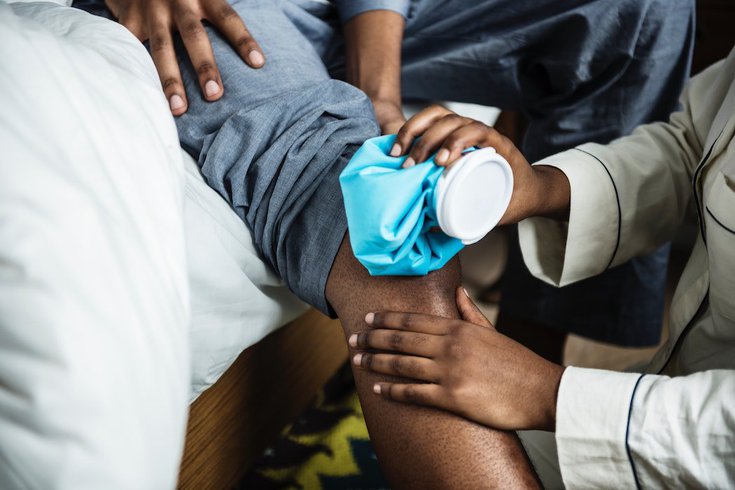
May 18, 2021
 rawpixel.com/Pexels
rawpixel.com/Pexels
Both ice and heat have properties that soothe pain, but pain management experts say they do it in different ways and can't be used interchangeably.
Whether you twist your ankle tripping off the curb or wake up every day with stiff, painful joints from arthritis, pain takes a toll on our physical and mental well-being.
Both ice and heat have properties that soothe pain, but pain management experts say they do it in different ways and can't be used interchangeably.
Ice reduces inflammation and bleeding, while numbing the pain. Heat increases blood flow, relaxing tight muscles. Using the wrong one at the wrong time could make the pain worse.
The acronym "RICE" is often used to promote the use of rest, ice, compression and elevation for skeletal muscle injuries. Heat applied via warm compresses is generally recommended for more chronic pain, but even some of these conditions, like gout, can respond better to icing or cold compresses, studies have shown.
In some cases, OrthoCarolina doctors say using a cycle of ice and then heat – which causes blood vessels to narrow and then dilate – can more effectively reduce inflammation. This is a more advanced treatment though and should be discussed with your doctor first.
Knowing the cause of an injury and how the severity of the damage are also important to consider when choosing the right type of pain relief, experts say.
If you are diagnosed with tendinitis, the painful inflammation of a tendon such as your Achilles tendon, ice is best to ease the pressure and numb the pain. However, if the tendon pain is caused by tendinosis, which is the chronic degeneration of the tendon, once the inflammation has been treated with ice, heat is best for relieving any stiffness.
The severity of a muscle injury should also be considered, according to a recent study. Researchers from Kobe University and Chiba Institute of Technology used a mouse model to study how icing affects muscle regeneration. They found that in severe injuries where the muscle is torn, icing actually delays healing.
They explained in their study, published in the Journal of Applied Physiology, that cold temperature delays the arrival of pro-inflammatory macrophages which remove damaged tissue. By suppressing the body's natural inflammatory response to an injury, ice can inhibit the body's ability to repair itself.
"In sports, the mantra of immediately applying ice to an injury is commonplace, regardless of the injury's severity. However, the mechanism that we illuminated through this research suggests that not icing a severe muscle injury may lead to faster recovery," said Associate Professor Arakawa Takamitsu.
Previous studies have reported conflicting results on whether icing delays muscle regeneration or not. This latest study is the first to use an injury model that imitates the mechanism behind common sports injuries. Torn muscles were treated with ice on top of the skin for at least three 30 minutes sessions a day, each two hours apart, for two days post-injury.
Two weeks after the injury, the muscles that were iced had a higher percentage of smaller regenerated muscle fibers compared to the muscles not treated with ice.
By studying the regeneration process, researchers observed that the ice was making it more difficult for the pro-inflammatory macrophages to enter the injured muscle and clean up the damaged tissues to trigger the healing process.
It can get confusing knowing which pain relief method is best for your particular situation. To help, the experts at Cleveland Clinic, Johns Hopkins University and OrthoCarolina have come up with some general rules to follow:
1. When an injury is acute or less than six weeks old, always choose ice. The cold temperature will cause the blood vessels to constrict, which numbs the pain. It also reduces inflammation and bruising.
2. For injuries that linger for longer than six weeks, heat can help improve range of motion of an injured joint. The warm temperature increases blood flow, relaxes tight muscles and relieves any aches or pain. Heat is also good to use before stretching or exercise.
3. Arthritis wears away at the cartilage in joints and can be a very painful condition. Rheumatologists say moist heat from a soak in the tub or a warm shower helps best for this type of chronic pain. For gout flare-ups, however, ice is the best option to reduce the inflammation.
4. When it comes to headache pain, neurologists suggest using a cold compress on the forehead, but also putting a moist heat compress on the neck if you are having neck spasms.
Whether you choose to use heat or ice for pain relief, the experts always recommend applying in a cycle of about 20 minutes on and 20 minutes off. When pain or injury is new or doesn't seem to be responding to treatment, always talk to your physician about the best course to take.